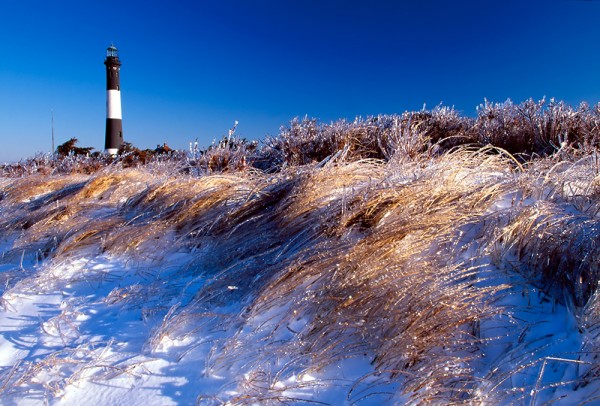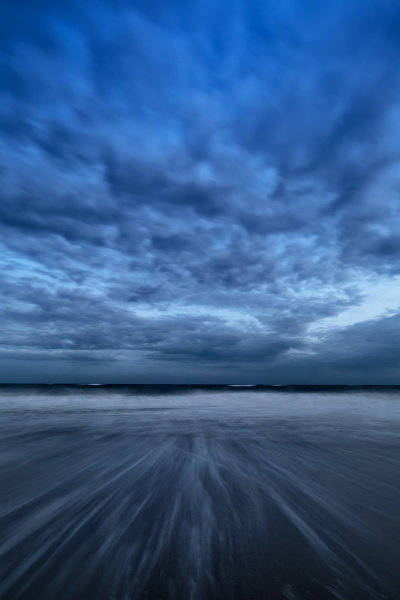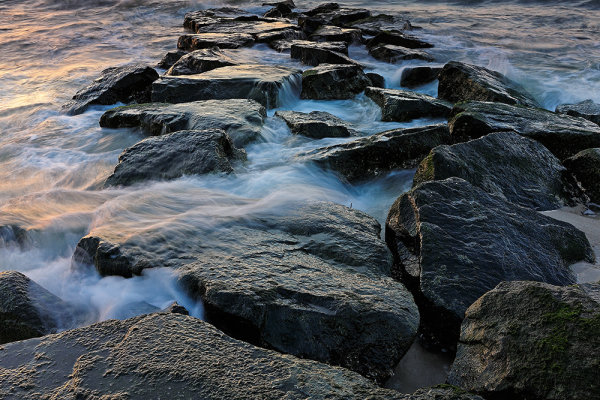
This shot was taken just after a January snow storm. The ice glistening on the dune grass made for an excellent foreground while the lighthouse towered in the background. A polarizer was used to help darken the sky. Taken with the EOS 5D Mark II and EF 16-35mm f/2.8L II. ISO 100, 1/250 at f/16.
Living on the east coast of the United States, I have easy access to any number of beaches to use as subjects for my photographic purposes. While many of these beaches may not be as dramatic as those on the west coast, they offer many photographic opportunities and shouldn’t be overlooked. Most people think of the beach as being a summer destination, but I’ve found it to be an excellent location all year round for a variety of reasons.

Dramatic skies and rushing water can make even the simplest composition interesting. I used a low point of view and a slower shutter speed to capture the water rushing straight at the camera, ready to grab the tripod if the water knocked the tripod over. The clouds eliminated any bright sunlight and created an almost monochromatic image. EOS 5D Mark III with EF 14mm f/2.8L II. Exposure was 8 seconds, f/20, ISO 100.
Photographing Seaside Landscapes poses a number of problems for the photographer. There’s wind, sand, and water to contend with, and keep out of your equipment. There are some precautions you can take to minimize the chances of disaster striking.
First, I usually spread a blanket out and put my camera bag down on that. It helps prevent sand from getting the seams of the bag, and it also lets the flap of my backpack rest somewhere other than sand. I speak from experience when I say that resting that lid on the sand and then flipping it up to close it is a good way to get sand inside the bag.
The next issue is the water. Obviously, the most basic rule is to keep your bag as far away from the water as possible. Pay attention to the tides and watch that the waves aren’t coming closer to where you’ve stashed your gear. But that’s only half the issue. Generally when I’m at the beach, water is at the very least a major part of what I’m shooting. I tend to take a few chances here. I like low angles, and dramatic shots. That tends to put my camera right in harm’s way. If I’m not on a tripod, I ensure that the strap is always around my neck to keep it from falling. If I’m on a tripod, I tend to keep my hand ready at all times to grab it and move if a big wave comes. If it helps you feel more secure, you can always use a rain cape to protect from splash, or if submersion may be possible, an underwater housing might be called for. I don’t personally use any of these items and just use a lot of care when near the water, but I have heard many horror stories of cameras that went swimming.
Sunrise and sunset are my favorite times for the soft warm light they provide. I use graduated neutral density filters when they are called for, depending on the light, as well as standard neutral density filters to help control my shutter speed to determine how I render water.
I find myself going back to the same beaches over and over. By their nature, they change often, as weather erodes them, tides build them back up, and secrets beneath the sand are revealed. Often after a storm is the best time, as the combination of wind and rain will create patterns in the sand and pools of water which create beautiful reflections.
Where do you find yourself visiting over and over to fulfill your photographic urges?

This shot is actually a west coast beach- Pelican Point in Laguna, California. A 4 stop ND grad was used to darken the sky. The foreground is a large rock with a beautiful pattern of cracks for interest. EOS 5D Mark III with EF 16-35mm f/2.8L II. 1 second at f/16, ISO 400.

This shot was taken at sunrise, as the tide was coming in. Water continually washed over the jetty, and the light playing on the water and rocks captured my interest. EOS-1D X with EF 16-35mm f/2.8L II. Exposure was .4 seconds at f/16, ISO 100. A 3 stop neutral density filter was also used.
Have you had any success with Photographing Seaside Landscapes? Share your images and tips in comments below.
Post originally from: Digital Photography Tips.
Check out our more Photography Tips at Photography Tips for Beginners, Portrait Photography Tips and Wedding Photography Tips.
A Day At The Beach: Photographing Seaside Landscapes
The post A Day At The Beach: Photographing Seaside Landscapes by Rick Berk appeared first on Digital Photography School.
You must be logged in to post a comment.